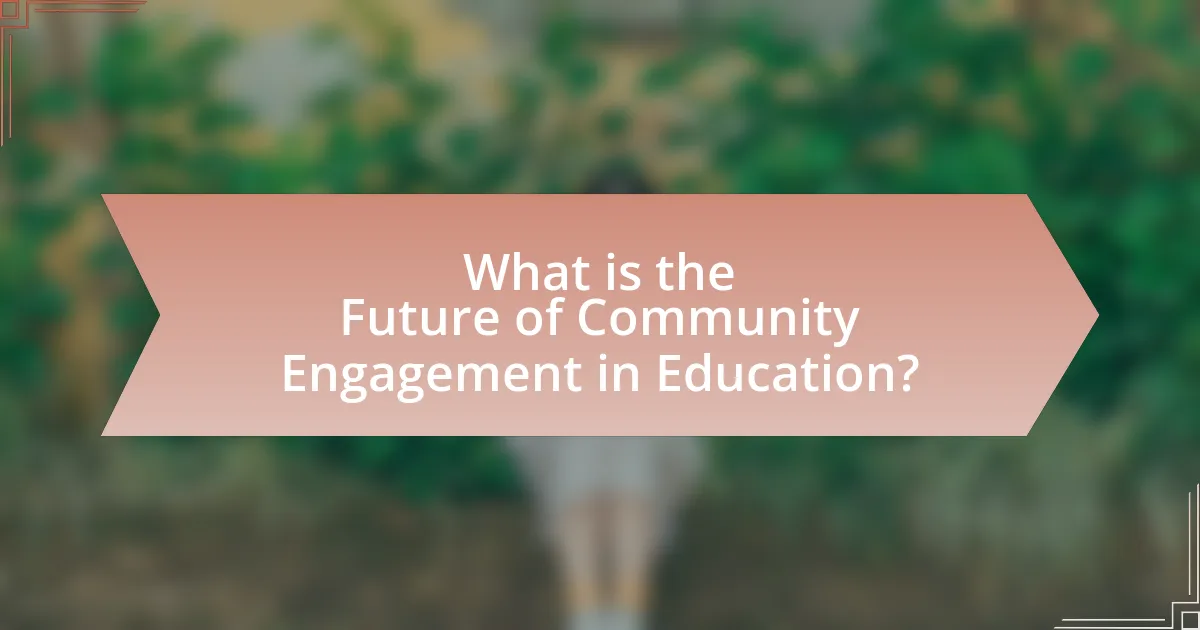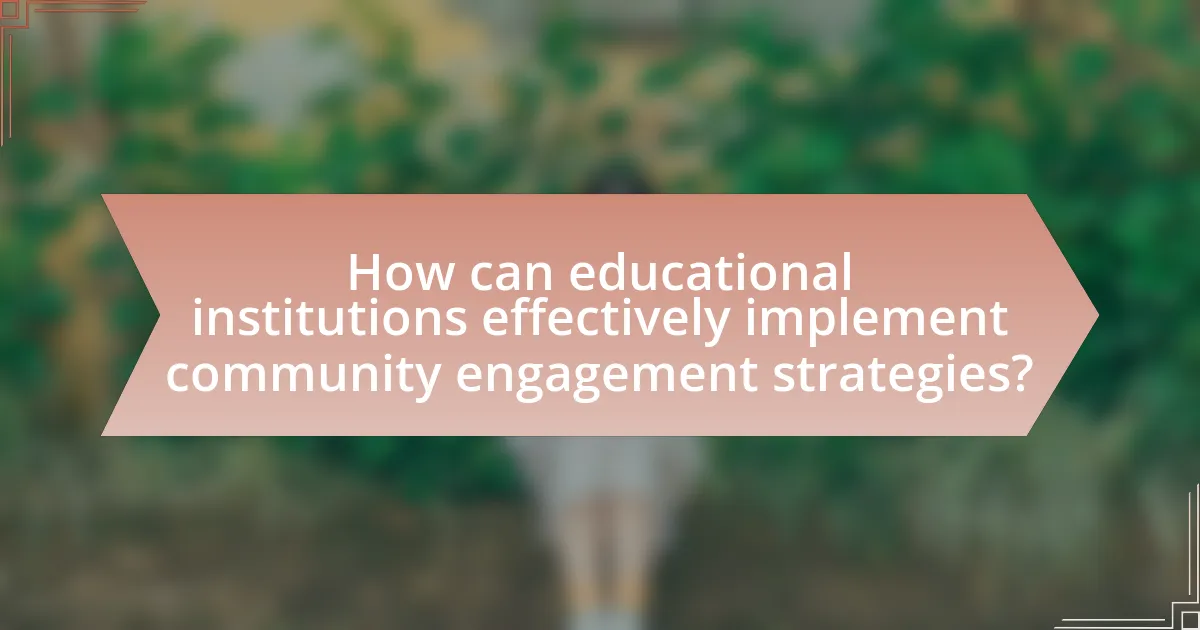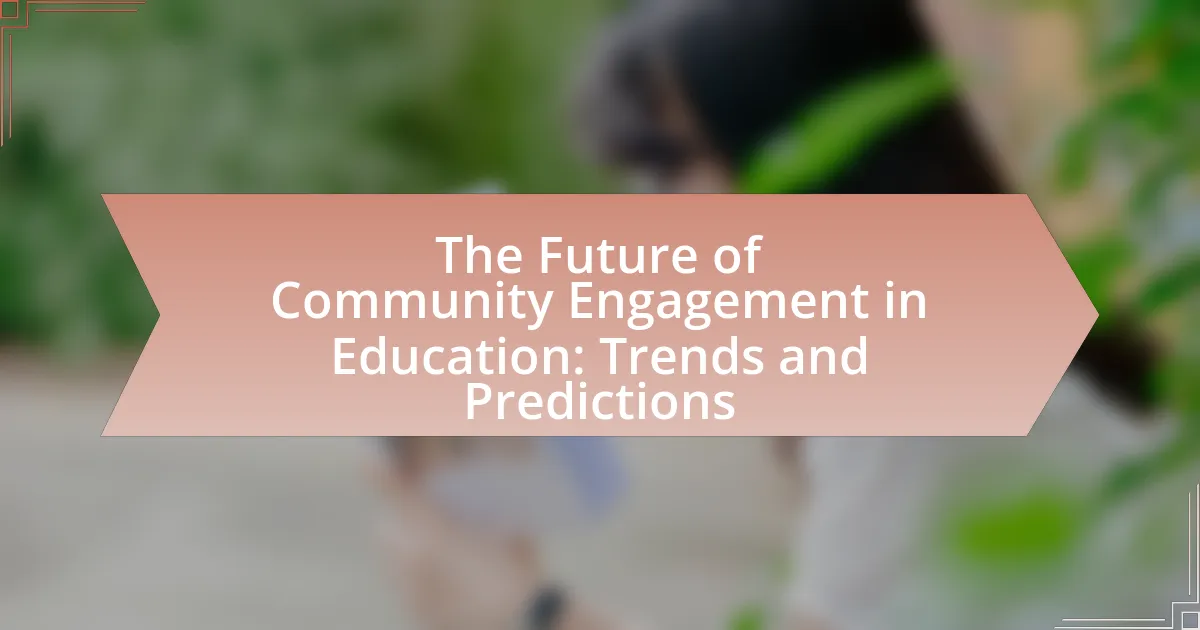The article focuses on the future of community engagement in education, emphasizing the importance of collaborative partnerships among schools, families, and local organizations. It outlines how effective community engagement enhances student learning outcomes, including higher grades and graduation rates, and highlights key components such as collaboration, communication, inclusivity, and sustainability. The article also discusses the role of technology in facilitating these connections, the varying levels of engagement across educational stages, and the benefits for both students and teachers. Additionally, it addresses emerging trends, challenges, and practical strategies for educational institutions to foster meaningful community involvement.

What is the Future of Community Engagement in Education?
The future of community engagement in education will increasingly focus on collaborative partnerships between schools, families, and local organizations. This shift is driven by the recognition that holistic educational experiences enhance student learning and well-being. Research indicates that schools with strong community ties see improved student outcomes; for instance, a study by the Harvard Family Research Project found that students whose families are engaged in their education have higher grades and test scores. Additionally, technology will play a crucial role in facilitating these connections, enabling real-time communication and resource sharing among stakeholders. As educational institutions prioritize inclusivity and responsiveness to community needs, the landscape of community engagement will evolve to foster more meaningful and impactful collaborations.
How is community engagement defined in the context of education?
Community engagement in the context of education is defined as the collaboration between educational institutions and the community to enhance learning experiences and outcomes. This collaboration often involves partnerships with local organizations, families, and community members to create a supportive environment for students. Research indicates that effective community engagement can lead to improved student achievement, increased attendance, and higher graduation rates, as evidenced by studies such as the “Community Schools: A Strategy for Integrating Community Engagement and Education” report by the Coalition for Community Schools, which highlights successful models of community involvement in education.
What are the key components of effective community engagement in educational settings?
The key components of effective community engagement in educational settings include collaboration, communication, inclusivity, and sustainability. Collaboration involves partnerships between schools, families, and community organizations to enhance educational outcomes. Effective communication ensures that all stakeholders are informed and can contribute to discussions, fostering transparency and trust. Inclusivity guarantees that diverse voices and perspectives are represented, which enriches the educational experience and promotes equity. Sustainability focuses on creating long-term relationships and ongoing support systems that adapt to changing community needs. Research indicates that schools with strong community engagement see improved student performance and increased parental involvement, highlighting the importance of these components.
How does community engagement differ across various educational levels?
Community engagement varies significantly across educational levels, with younger students typically participating in more structured and guided activities, while higher education students engage in more autonomous and diverse forms of involvement. For instance, elementary and middle school students often engage in community service projects organized by their schools, which fosters a sense of teamwork and responsibility. In contrast, high school students may take part in volunteer opportunities that allow for greater choice and personal interest, reflecting their developing independence. At the university level, students often engage in community initiatives through internships, research projects, or service-learning courses, which not only enhance their academic experience but also contribute to their professional development. This progression illustrates how community engagement evolves from guided participation to self-directed involvement, aligning with the increasing autonomy and critical thinking skills developed at each educational stage.
Why is community engagement important for educational institutions?
Community engagement is important for educational institutions because it fosters collaboration between schools and their surrounding communities, enhancing educational outcomes. Engaging with the community allows institutions to align their curricula with local needs, ensuring that students acquire relevant skills and knowledge. Research indicates that schools with strong community ties see improved student performance, higher graduation rates, and increased parental involvement, which are critical factors for academic success. For instance, a study by the National Education Association found that schools that actively engage with their communities report a 20% increase in student achievement. This collaboration not only enriches the educational experience but also builds a supportive network that benefits both students and the community at large.
What benefits does community engagement provide to students?
Community engagement provides students with enhanced learning experiences, practical skills, and a sense of social responsibility. Engaging with the community allows students to apply theoretical knowledge in real-world contexts, fostering critical thinking and problem-solving abilities. Research indicates that students involved in community service demonstrate improved academic performance and higher retention rates, as evidenced by a study published in the Journal of Higher Education Outreach and Engagement, which found that 85% of students participating in service-learning reported a deeper understanding of course material. Additionally, community engagement cultivates interpersonal skills and empathy, preparing students for diverse workplaces and societal challenges.
How does community engagement enhance the educational experience for teachers?
Community engagement enhances the educational experience for teachers by fostering collaboration and support from local stakeholders. When teachers actively involve parents, businesses, and community organizations, they gain access to resources, expertise, and diverse perspectives that enrich the learning environment. Research indicates that schools with strong community ties report higher teacher satisfaction and retention rates, as evidenced by a study from the National Education Association, which found that 75% of teachers in engaged communities felt more supported in their roles. This collaborative atmosphere not only improves teaching practices but also leads to better student outcomes, creating a positive feedback loop that benefits educators and learners alike.
What trends are shaping the future of community engagement in education?
Trends shaping the future of community engagement in education include increased use of technology, a focus on inclusivity, and collaborative partnerships. The integration of digital platforms facilitates real-time communication and resource sharing among educators, students, and community members, enhancing engagement. Research indicates that schools utilizing technology for community outreach see a 30% increase in participation rates (National Center for Education Statistics, 2021). Additionally, prioritizing inclusivity ensures diverse voices are represented, fostering a sense of belonging and ownership in educational processes. Collaborative partnerships between schools, local organizations, and families create a support network that enriches educational experiences, as evidenced by programs that report improved student outcomes through community involvement (Harvard Family Research Project, 2020).
How is technology influencing community engagement practices?
Technology is significantly influencing community engagement practices by enhancing communication, accessibility, and participation. Digital platforms, such as social media and community apps, facilitate real-time interaction and information sharing among community members, leading to increased involvement in local initiatives. For instance, a study by the Pew Research Center found that 69% of adults in the U.S. use social media, which serves as a vital tool for organizing events and mobilizing support for community projects. Additionally, technology enables remote participation through virtual meetings and webinars, allowing individuals who may have previously faced barriers to engage actively. This shift towards digital engagement reflects a broader trend of integrating technology into community practices, ultimately fostering a more inclusive and participatory environment.
What role do social media platforms play in fostering community connections?
Social media platforms play a crucial role in fostering community connections by providing spaces for individuals to interact, share information, and collaborate. These platforms enable users to form groups based on shared interests, facilitating communication and engagement among community members. For instance, Facebook groups and Twitter hashtags allow educators, parents, and students to connect, share resources, and discuss educational topics, thereby enhancing community involvement in education. Research indicates that 72% of teachers use social media for professional development, highlighting its effectiveness in building networks and support systems within educational communities.

What predictions can be made about community engagement in education?
Predictions about community engagement in education indicate an increase in collaborative partnerships between schools and local organizations. This trend is supported by research showing that schools with strong community ties experience improved student outcomes, such as higher graduation rates and enhanced academic performance. For instance, a study by the Harvard Family Research Project found that schools engaging families and communities effectively can lead to a 10-20% increase in student achievement. Additionally, the integration of technology is expected to facilitate more inclusive and diverse community participation, allowing for broader input and support in educational initiatives.
How will community engagement evolve in the next decade?
Community engagement will increasingly leverage technology and data analytics over the next decade. As educational institutions adopt digital platforms, they will facilitate more inclusive and interactive participation from diverse community members. For instance, the rise of social media and mobile applications will enable real-time communication and feedback, enhancing collaboration between schools and communities. Research indicates that schools utilizing technology for engagement see improved student outcomes and stronger community ties, as evidenced by a study from the National Education Association, which found that schools with active community involvement programs report a 20% increase in student performance metrics. This trend will likely continue, making community engagement more dynamic and responsive to local needs.
What emerging models of community engagement are being developed?
Emerging models of community engagement being developed include participatory budgeting, asset-based community development, and digital engagement platforms. Participatory budgeting allows community members to directly influence budget allocations, fostering transparency and accountability. Asset-based community development focuses on leveraging existing community strengths and resources to drive initiatives, promoting sustainable growth. Digital engagement platforms utilize technology to facilitate communication and collaboration among community members, enhancing participation and inclusivity. These models are increasingly recognized for their effectiveness in building stronger, more resilient communities.
How might policy changes impact community engagement strategies?
Policy changes can significantly impact community engagement strategies by altering the frameworks within which educational institutions operate. For instance, when policies prioritize inclusivity and equity, schools may adopt more collaborative approaches that actively involve diverse community stakeholders in decision-making processes. Research indicates that policies promoting parental involvement lead to increased student achievement and stronger community ties, as seen in studies conducted by the Harvard Family Research Project, which found that effective engagement strategies correlate with improved educational outcomes. Thus, the nature of policy changes directly influences the methods and effectiveness of community engagement in educational settings.
What challenges might arise in the future of community engagement?
Challenges in the future of community engagement include digital divide issues, lack of trust, and evolving communication preferences. The digital divide can hinder participation, as not all community members have equal access to technology or the internet, which is increasingly necessary for engagement. Additionally, trust in institutions may decline, making it difficult for organizations to mobilize community members effectively. Evolving communication preferences, particularly among younger generations who favor social media and instant messaging, may also complicate traditional engagement methods. These factors collectively threaten the effectiveness and inclusivity of community engagement efforts in educational contexts.
How can educational institutions address potential barriers to engagement?
Educational institutions can address potential barriers to engagement by implementing inclusive practices and fostering a supportive environment. By actively promoting diversity and accessibility, schools can ensure that all students feel valued and included. Research indicates that institutions that adopt universal design for learning principles see increased participation rates, as these strategies accommodate various learning styles and needs. For instance, a study by the National Center on Universal Design for Learning found that schools employing these methods reported a 20% increase in student engagement. Additionally, providing resources such as mentorship programs and community partnerships can further enhance student involvement, creating a more connected and engaged educational experience.
What strategies can be implemented to overcome resistance from stakeholders?
To overcome resistance from stakeholders, effective strategies include transparent communication, active involvement, and addressing concerns directly. Transparent communication fosters trust by ensuring stakeholders are informed about decisions and changes, which can reduce uncertainty and anxiety. Actively involving stakeholders in the decision-making process empowers them and makes them feel valued, leading to greater buy-in. Addressing concerns directly through feedback mechanisms allows stakeholders to express their apprehensions, which can then be mitigated through tailored solutions. Research indicates that organizations that prioritize stakeholder engagement and communication experience higher levels of support and collaboration, as evidenced by a study published in the Journal of Community Engagement and Scholarship, which highlights the correlation between stakeholder involvement and project success rates.

How can educational institutions effectively implement community engagement strategies?
Educational institutions can effectively implement community engagement strategies by establishing partnerships with local organizations and stakeholders. These partnerships facilitate resource sharing, enhance educational programs, and create opportunities for students to participate in community service projects. For instance, a study by the National Service-Learning Clearinghouse found that schools engaging in service-learning initiatives reported improved student academic performance and increased civic responsibility. Additionally, institutions can host community forums to gather input and foster collaboration, ensuring that engagement efforts align with community needs. This approach not only strengthens ties between schools and communities but also enriches the educational experience for students.
What best practices should be followed for successful community engagement?
Successful community engagement requires active listening, transparency, and collaboration. Active listening ensures that community members feel heard and valued, fostering trust and participation. Transparency in communication builds credibility, as stakeholders are informed about decisions and processes. Collaboration among educators, families, and community organizations enhances resource sharing and collective problem-solving. Research indicates that schools with strong community ties see improved student outcomes, as evidenced by a study from the Harvard Family Research Project, which found that effective family and community engagement leads to higher student achievement and better school performance.
How can schools measure the effectiveness of their community engagement efforts?
Schools can measure the effectiveness of their community engagement efforts through surveys, participation rates, and feedback mechanisms. Surveys can assess community perceptions and satisfaction levels, while participation rates in events and programs indicate engagement levels. Additionally, feedback mechanisms, such as focus groups or community forums, provide qualitative insights into the impact of engagement initiatives. Research shows that schools with structured evaluation processes for community engagement report higher satisfaction and improved relationships with stakeholders, demonstrating the importance of these measurement tools.
What role do partnerships play in enhancing community engagement initiatives?
Partnerships play a crucial role in enhancing community engagement initiatives by leveraging diverse resources, expertise, and networks. These collaborations enable organizations to reach a broader audience, foster trust, and create more impactful programs. For instance, a study by the National Community Engagement Network found that partnerships between schools and local businesses increased student participation in community service projects by 40%, demonstrating the effectiveness of collaborative efforts in driving engagement.
What practical steps can educators take to foster community engagement?
Educators can foster community engagement by implementing collaborative projects that involve local stakeholders. For instance, organizing service-learning initiatives allows students to work on real-world problems alongside community members, enhancing both educational outcomes and community ties. Research indicates that such partnerships can improve student motivation and academic performance, as evidenced by a study published in the “Journal of Community Engagement and Scholarship,” which found that students involved in service-learning reported higher levels of civic responsibility and engagement. Additionally, hosting community forums and workshops can facilitate open dialogue between educators and community members, ensuring that educational practices align with local needs and values.
How can educators involve parents and families in the learning process?
Educators can involve parents and families in the learning process by implementing regular communication strategies, such as newsletters, parent-teacher conferences, and digital platforms for updates on student progress. Research indicates that effective communication increases parental engagement, which is linked to improved student outcomes. For instance, a study published in the “Journal of Educational Psychology” found that students whose parents are actively involved in their education tend to achieve higher academic performance and exhibit better behavior in school. Additionally, educators can organize workshops and family events that encourage participation in school activities, fostering a collaborative environment that supports student learning.
What activities can be organized to strengthen community ties within schools?
Organizing community service projects can effectively strengthen community ties within schools. These projects, such as neighborhood clean-ups, food drives, or tutoring programs, encourage collaboration among students, parents, and local organizations. Research indicates that schools engaging in community service foster a sense of belonging and responsibility among students, which enhances their connection to the community. For instance, a study by the Corporation for National and Community Service found that students who participate in service-learning programs demonstrate improved academic performance and social skills, reinforcing the importance of community involvement in educational settings.


